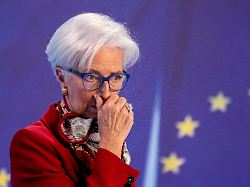Inflation tough, banks groan
Why Lagarde uses the interest rate hammer
An analysis by Jan Ganger
03/16/2023, 6:45 p.m
Despite the severe turbulence in bank stocks, the European Central Bank is continuing to hike interest rates at a fast pace. It has no other choice if it wants to get high inflation under control in the near future.
“We stay on course” – that is the motto of ECB boss Christine Lagarde. From this point of view, it is only logical that the European Central Bank continues to raise key interest rates sharply – even though the rate of interest rates set by the European and US central banks is causing problems in the banking sector and has caused severe turbulence on the financial markets.
But the ECB is in a bind. In view of the high inflation in the euro zone, it feels compelled to raise interest rates further. In February – this is the most recent data – prices in the common currency area rose by a whopping 8.5 percent compared to the previous year.
Therefore, it was considered a foregone conclusion that the ECB will decide at its council meeting to raise the key interest rate by 0.5 percentage points to 3.5 percentage points. Commercial banks can borrow money from the ECB at this rate.
The bankruptcy of the US regional bank SVB (SVB), meanwhile, has triggered a crisis of confidence in financial institutions, which was exacerbated by the home-made problems of the Swiss Credit Suisse. As a result, doubts have been growing over the past few days as to whether the ECB really will not put the brakes on interest rates. Because a lower interest rate increase would relieve the banks somewhat. The SVB had invested heavily in US government bonds, which, however, lost a lot of their market value due to rising interest rates. Fearing a collapse, investors withdrew their money – and then brought the bank to the brink of collapse.
Memories of Lehman Brothers
However, the ECB was not only prevented from doing so by high inflation. Central bankers – above all Head Lagarde – had promised that they would raise the key interest rate by exactly half a percentage point this Thursday. The ECB communicates its future monetary policy decisions more or less openly in advance. In doing so, she wants to ensure that financial market players and governments, for example, can adapt to this.
“Forward Guidance” is the name of this principle. And the ECB definitely wants to stick to that. There are two main reasons for this, which are related to each other. On the one hand, the ECB does not want to surprise the financial markets and does not want to risk triggering severe turbulence there with an abrupt change of course. On the other hand, the central bankers don’t want to damage their most important tool: credibility.
Against this background, a lower rate hike than the one promised could have been interpreted as a fatal signal – namely that the central bankers are only taking their foot off the accelerator because the banks are in a very bad way. After the rate hike, Lagarde assured Wall Street bank Lehman Brothers that “the banking sector is much, much stronger than it was in 2008.” He is resilient, capital and liquidity buffers are solid.
In addition, the ECB’s reputation has lost some of its luster due to high inflation. In order to polish the reputation again, it wants to consistently push inflation into the green and fulfill its mandate to ensure price stability. She’s a long way from that. The central bank sees stable prices when the inflation rate is 2 percent.
Trichet was wrong
The most powerful monetary policy weapon against inflation is interest rate hikes. The mechanism: If loans become more expensive, this slows down both consumption and investment and thus demand. This tends to dampen prices. However, it will take some time for the interest rate hikes to take full effect. The rule of thumb is between 12 and 18 months.
The ECB abandoned its zero interest rate policy last summer and has been raising interest rates at a rapid pace ever since. Despite rising inflation, the central bankers had long shied away from raising interest rates. They had assumed that the high inflation rates were temporary. However, that was a mistake – which is also due to Russia’s attack on Ukraine, which at times drove energy prices to dizzying heights. The logic behind this: Higher interest rates neither ensure low energy prices nor that messed up supply chains function again.
The ECB stuck to its ultra-loose monetary policy even as doubts grew in the central bank as to whether inflation would actually fall again on its own. Ironically, this was largely due to the principle that the central bank still adheres to today: “Forward Guidance”. She shied away from changing her prospective interest rate too quickly.
This is also due to the fact that the central bankers are stuck with a decision made by the ECB in 2011. At the time, the bank, under then-ECB President Jean-Claude Trichet, continued to raise interest rates in a bid to quell eurozone inflation, which was below 3 percent at the time. The ECB thus fueled the debt crisis in the euro zone. After a few months, the course was reversed.
